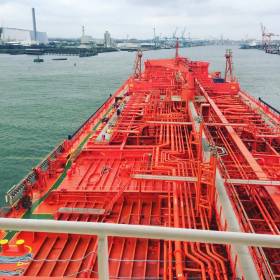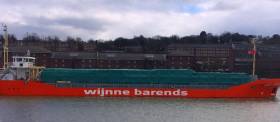Displaying items by tag: Iver Ability
Tanker Snapshot: Molasses from Guatemala Via Amsterdam Discharged in Dublin
#TankerSnap – The above photograph is not of the red-hulled tanker Iver Ability which anchored in Dublin Bay for more than five months and in doing so drew much mainstream media attention, writes Jehan Ashmore.
So what is the identity of this tanker?... with this view overlooking the vessel's complex looking cargo tanks pipeline network. The answer to the vessel's identity is that of the MS Simon, a 40,000dwt Liberian flagged oil-chemical bulk liquids tanker.
The vessel had berthed in Dublin Port nine days ago with a cargo of molasses from Guatemala in Central America. This followed a crossing of the Atlantic, where MS Simon made an en-route call to Amsterdam prior to docking in Dublin Port.
The 176m long vessel discharged the molasses at a northside fuel jetty before shifting to the south bank along Deepwater Quay.
At this same berth (No.47) is where previously Iver Ability made several calls during the prolonged anchorage that arose following a 'cargo reaction' incident in transporting bitumen in the port.
The final port call was prior to the festive season. On that occasion a change of certain personnel of the 129m vessel was undertaken.
Late last month Iver Ability finally departed Dublin Bay bound for the Netherlands.
On completion of duties that is of the MS Simon, the tanker departed the capital this week. On Thursday the ship was monitored offshore of the Scottish coast. At that stage the tanker was off Islay, the southernmost of the Inner Hebrideas.
Scotline Take Time-Charter of Dutch Short-Sea Ship Trading to Ireland
#Scotline – Scotline the short-sea timber products operator recently took a time-charter of Lady Ariane which berthed in Wicklow Port today, writes Jehan Ashmore.
The box shaped singledecker had sailed from the Swedish port of Varberg. The Scandinavian port that firmly established Scotline as an operator from the late 1970’s in the transportation of forest-product cargo of logs from Inverness.
In the present day, the company are responsible for transporting a high percentage of all softwood (packaged timber) into the UK through operating liner services. This includes operations to Ireland.
The time charter of Lady Ariane is from Dutch short-sea operator, Wijnne Barends. Also added to the fleet is Scot Leader which was recently acquired and brings the fleet total to 12 vessels.
In regards to Wijnne Barends they are based in Delfzijl. The North Sea port is where the asphalt/bitumen tanker Iver Ability is bound to.
The red-hulled ship anchored in Dublin drew much public attention following months spent offshore following a ‘reaction’ during transport of bitumen in Dublin Port last summer.
Iver Ability was monitored yesterday by Afloat while transiting the Strait of Dover. At it’s narrowest point the distance of the Strait is a mere 33.3 kilometres (20.7 miles).
On a daily basis there is around 400 vessels transiting through the Strait, the world’s busiest channel. Asides ships of many types there are ferries criss-crossing between the Port of Dover (see record freight) and the French ports of Calais and Dunkerque.
This afternoon the tanker is at anchorage of the West Frisian Islands. The archipelago lies off the approaches to the Ems Estuary that leads to Delfzijl.
Long Stay Red Tanker 'Iver Ability' Departs Dublin Bay for Dutch Port
Iver Ability, the red hulled ship, anchored in Dublin Bay since August, left its six–month mooring yesterday, bound for the Dutch Port of Delfzijl.
The long term anchorage of the ship followed a 'reaction' onboard the Asphalt/Bitumen tanker during her transport of Bitumen into Dublin Port this summer.
The ship cut a lonely sight over Christmas 2016, as 'discussions with charterers' for a port of discharge for the vessel’s cargo continued.
While at anchorage in Dublin, the ship was fully operational with all seafarers performing normal duties and standard crew changes taking place, according to the ship's managers.


























































